Abundant Soliton Structures to the (2 + 1)-Dimensional Heisenberg Ferromagnetic Spin Chain Dynamical Model
Abstract
In this paper, we aim to investigate the (2 + 1)-dimensional Heisenberg ferromagnetic spin chain equation that is used to describe the nonlinear dynamics of magnets. Two recent effective technologies, namely, the variational method and subequation method, are employed to construct the abundant soliton solutions. By these two methods, diverse solutions such as the bright soliton, dark soliton, bright-dark soliton, perfect periodic soliton, and singular periodic soliton are successfully extracted. The numerical results are illustrated in the form of 3-D plots and 2-D curves by choosing proper parametric values to interpret the dynamics of wave profiles. Finally, the physical interpretation of the acquired results is elaborated in detail. The results obtained in this study are helpful to explain some physical meanings of some nonlinear physical models in electromagnetic waves.
1. Introduction
The (2 + 1)-dimensional HFSCE is used to describe the nonlinear dynamics of magnets. In [33], the two methods, improved auxiliary equation and generalized Riccati mapping methods, are used to seek for the diverse solitons. In [34], the Jacobi elliptic expansion method is adopted and bright and dark soliton solutions are obtained. In [35], the theory of dynamical systems is introduced for constructing the bounded traveling wave solutions. In [36], the modified Khater method is carried out to deal with Eq. (1). The generalized tanh methods is employed to solve Eq. (1) in [37], and dark, dark-bright, or combined optical and singular soliton solutions are attained. In [38], the authors use two approaches, namely, the modified F-expansion and projective Riccati equation methods to investigate (Eq. (1)). Inspired by these research results, here in this work, we mainly seek its abundant soliton solutions by using two effective methods, the variational method (VM) and subequation method (SEM). The VM which is based on the variational theory can provide the optimized solutions in only one step via the stationary condition. In addition, the SEM that is straightforward and effective can construct abundant solutions via the symbolic calculation. The structure of this paper is organized as follows. In Section 2, we introduce the algorithms of the two methods. In Section 3, the two methods are applied to find the soliton solutions. In Section 3, the behaviors of the solutions and their physical interpretations are presented. Finally, a conclusion is reached in Section 5.
2. The Two Methods
2.1. The VM
Assuming that the solutions of Eq. (4) take the following different forms.
Hypothesis one: U(ξ) = H1sech(ξ).
Hypothesis two: U(ξ) = H2sech2(ξ).
Hypothesis three: U(ξ) = ((H3sinh(ξ))/([cosh(ξ)](3/2))).
Hypothesis four: U(ξ) = H4cos(ϖξ).
Then, taking the above-assumed expressions into Eq. (5) and applying the stationary conditions as
Result one: (dJ/dH1) = 0.
Result two: (dJ/dH2) = 0.
Result three: (dJ/dH3) = 0.
Result four: (dJ/dH4) = 0.
Solving the above different results, the expressions of H1, H2, H3, and H4 can be easily determined.
2.2. The SEM
Here, Ξ is a constant. Substituting Eq. (6) together with Eq. (7) into Eq. (4), we can determine the value of c by the balancing theory. With the determined c, we can get an overdetermined system of nonlinear algebraic equations by setting the coefficients of each power of φ(γ) to zero. Solving it, we can determine the expression of Eq. (6).
3. Applications
3.1. Application of the VM
3.1.1. Bright Soliton
3.1.2. Bright-Like Soliton
3.1.3. Bright-Dark Soliton
3.1.4. Periodic Soliton
3.2. Application of the SEM
Taking Eq. (43) along with Eq. (44) into Eq. (40) results into
φ0:
φ1:
φ2:
φ3:
Then, we get the solutions as follows:
Case 1. For ((k − γ1m2 − n(γ2n + γ3m))/(γ1a2 + γ2b2 + γ3ab)) < 0, we have
Case 2. For ((k − γ1m2 − n(γ2n + γ3m))/(γ1a2 + γ2b2 + γ3ab)) > 0, we have
4. Numerical Results and Physical Interpretation
In this section, we mainly illustrate the results gained in Section 3 through the 3-D plot and 2-D curve to interpret the dynamics of wave profiles by selecting the proper parameters.
We plot the 3-D plots of absolute value of the solutions , , , , and in Figures 1(a), 2(a), 3(a), 4(a), and 5(a), respectively, for t = 0. Besides, we also draw the 2-D curves of the absolute value of the solutions , , , , and in Figures 1(b), 2(b), 3(b), 4(b), and 5(b), respectively, for y = 0 and t = 0. It can be observed that the absolute values of and are the bright soliton wave and dark soliton, the absolute values of is the bright-dark soliton, and the absolute values of and are perfect periodic soliton and singular periodic soliton.
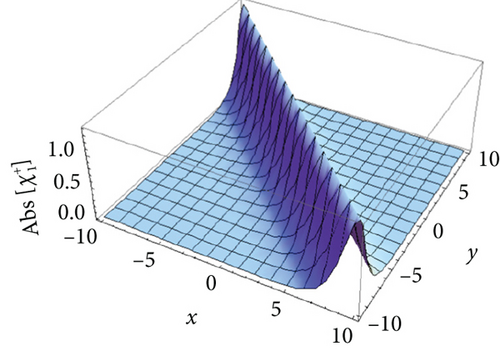

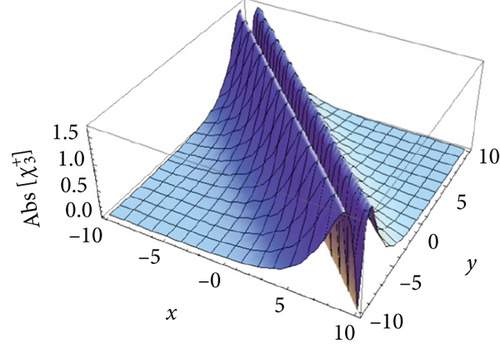
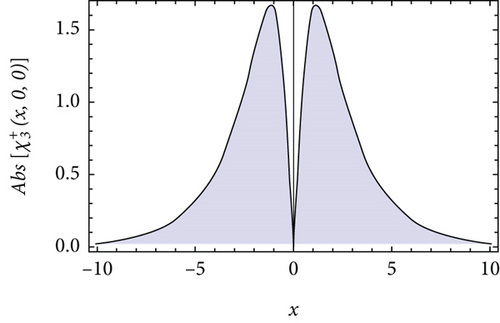

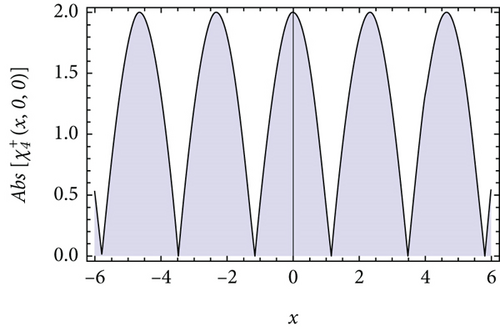
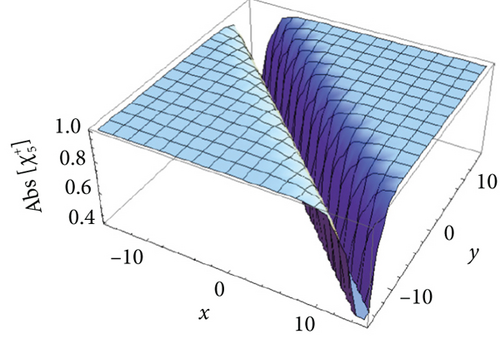
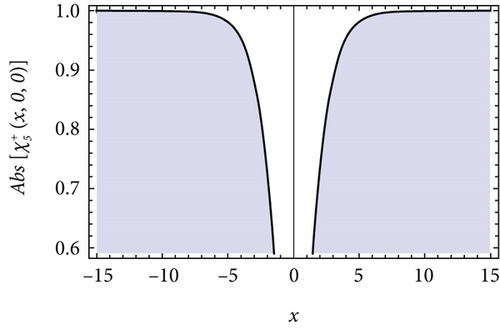
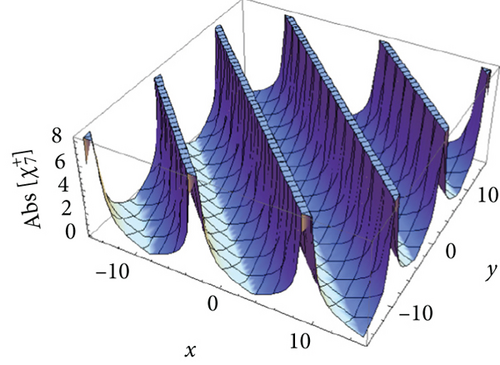
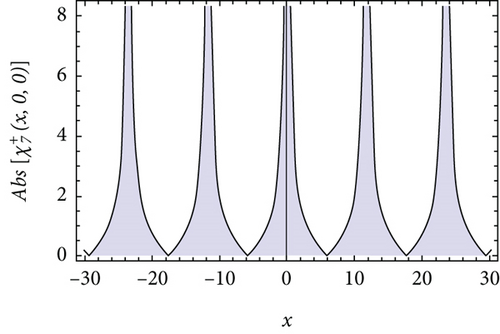
5. Conclusion and Future Recommendation
In this work, abundant soliton solutions of the (2 + 1)-dimensional HFSCE such as the bright soliton, dark soliton, bright-dark soliton, perfect periodic soliton, and singular periodic soliton are successfully constructed by means of the VM and SEM. The absolute parts of the solutions are presented through the 3-D plot and 2-D curve by assigning the proper parameters. In addition, we give the physical explanation of the solutions in detail. Through the calculation process, it can be found that the VM can reduce the order of the differential equation to simplify the equation via the variational theory. In addition, the SEM is effective and direct and can construct the different types of solitons. The methods adopted in this study can be used to investigate the other PDEs arising in the physics.
In recent years, the fractal and fractional derivatives [50–61] have attracted extensive attention in different fields. How to apply the proposed methods to study the fractal and fractional PDEs will be the focus of our future research.
Conflicts of Interest
This work does not have any conflicts of interest.
Acknowledgments
This work is supported by the Key Programs of Universities in Henan Province of China (22A140006), the Fundamental Research Funds for the Universities of Henan Province (NSFRF210324), Program of Henan Polytechnic University (B2018-40), and the Opening Project of Henan Engineering Laboratory of Photoelectric Sensor and Intelligent Measurement and Control, Henan Polytechnic University (HELPSIMC-2020-004). This work is also supported by the Innovative Scientists and Technicians Team of Henan Provincial High Education (21IRTSTHN016), Key Project of the Scientific and Technology Research of Henan Province (212102210224), and the Doctoral Fund Project of Henan Polytechnic University (No. B2014-028).
Open Research
Data Availability
The data that support the findings of this study are available from the corresponding author upon reasonable request.




